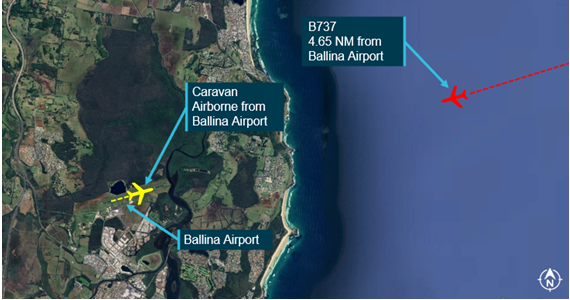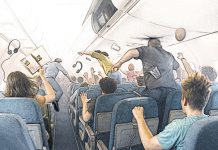An unnerving incident at Ballina Airport is a stern reminder of the importance of never making assumptions about airspace, or other aircraft – and of the trap posed by assumptions you don’t know you have made.
On the afternoon of 16 September 2021, a Cessna Caravan taxied onto the runway and began take-off towards a Boeing 737 that was 5 nm away on final approach. The flight crew of the 737 flew a missed approach to avoid the Caravan, during which they received a traffic collision avoidance system traffic advisory. The Caravan, which had turned south, had continued the turn to fly north and was ahead and slightly above the 737.
At the closest point of approach, the lateral separation between the 2 aircraft decreased to approximately 0.9 nm and vertical separation reduced to about 700 feet. At this point the Caravan was flying away from the 737. At the time of the incident, the aircraft were operating within the airport’s broadcast area and were both receiving a surveillance flight information service (SFIS).
The Australian Transport Safety Bureau (ATSB) investigation identified 4 instances where communication had failed.
- The SFIS controller had not included the 737’s estimated time of landing and runway direction when providing traffic information to the Caravan pilot.
- The Caravan pilot had formed the belief that the 737 would land on runway 06 (based on observing the runway windsock) and then interpreted the traffic information provided by the controller incorrectly as it confirmed their incorrect mental model. The pilot did not seek to validate this assumption by communicating directly with the 737’s flight crew or by querying the information provided by the controller.
- The scenario was further compounded by the 737’s flight crew not hearing the Caravan’s taxi broadcasts or the SFIS controller’s responses. Those taxi transmissions commenced 40 seconds before the 737 turned onto final approach for runway 24. The ATSB was not able to determine why the flight crew did not hear the exchange. In any case, they were not aware of the Caravan until the ‘entering and rolling’ broadcast made by its pilot.
- The SFIS controller knew the 737’s flight crew had not acknowledged the Caravan pilot’s taxi broadcast but recalled from SFIS training that follow-up communications were not necessary for aircraft already on the common traffic advisory frequency (CTAF). Consequently, the controller decided not to confirm that the flight crew were aware of the Caravan, and an opportunity to address the evolving situation was missed. This resulted in the 737’s flight crew remaining unaware of the Caravan, and the latter’s pilot continued to incorrectly believe the 737 would land in the opposite direction.
The Caravan pilot’s incorrect mental model also led them to believe their aircraft could take-off ahead of the landing 737, using runway 06, without any conflict. The pilot recalled conducting a visual check prior to entering the runway; however, their likely confirmation bias and reduced situation awareness possibly resulted in not sighting the approaching 737. Consequently, the Caravan was taxied onto the runway and a take-off commenced, directly towards the 737.
Patchy automatic dependent surveillance broadcast (ADS-B) coverage at Ballina contributed to the confusion, the ATSB investigation said.
*CASA conducted a Ballina Airspace Review which was published in December 2022. Among its 9 recommendations is the installation of an ADS-B ground station in the vicinity of Ballina Airport to enable ADS-B surveillance capability to the runway surface.
The recommendations are designed to incrementally transition Ballina Airport to a controlled aerodrome service with an associated control zone and control area steps by 13 June 2024.
One of the key findings of the ATSB investigation concerned safety at non-controlled airports. This is a key focus of CASA’s current pilot safety campaign which aims to raise awareness and understanding of the importance of radio calls.
Six webinars have been run, focusing on this topic; nearly 1,500 pilots registered to attend and more than 6,000 pilots watched them afterwards. Other materials and promotions on this topic included videos, podcasts, printed collateral and broader communications.






Comments are closed.